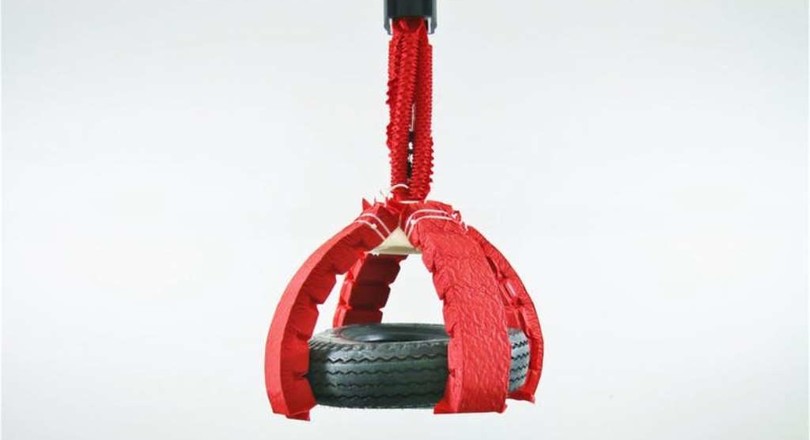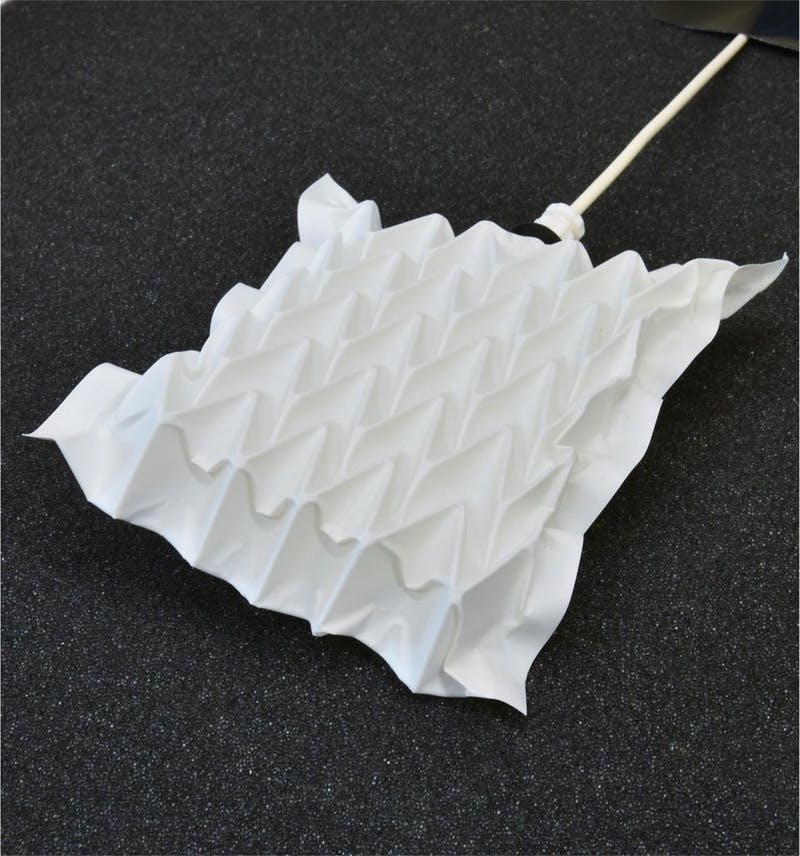
Scientists and engineers from Harvard University and MIT have come up with a mechanism for equipping robots with soft artificial ‘muscles’. A frame – a sort of skeleton – in an inflatable bag offers the possibility of various movements, depending on the shape.
Robots used in the car industry, for instance, are large, extremely strong and make rapid, firm movements. But for many robot applications, that approach is entirely unsuitable. These require a soft approach, soft robotics, for example because of the proximity to people.
At Harvard University and MIT, researchers have now made a sort of muscle from plastic that is light yet really quite strong. Some versions of the muscles can lift up to a thousand times their own weight. And that represents new ground for such research, as previous artificial muscles were much weaker. ‘We were very surprised by how strong the actuators – aka, “muscles” – were. We expected they’d have a higher maximum functional weight than ordinary soft robots, but we didn’t expect a thousand-fold increase’, said MIT's Professor Daniela Rus in a press release.
Frame
Each muscle has three parts. Firstly a frame made of a metal coil or a plastic skin that is folded into a certain shape. That is then surrounded by a ‘skin’ of plastic or rubber. The third, and most crucial part is the medium in this bag. This is either air or a liquid, but the main thing is that a vacuum is created in the muscle, causing it to shrink (and expand).
Pre-defined

movements made by the ‘muscle’ when inflated
or deflated.
The shape of the frame and the skin determine the movements made by the ‘muscle’ when inflated or deflated. Striking is the fact that the movements of the muscles are pre-defined in the material. In other words: due to the precise structure of the frame and the skin, the ‘muscle’ makes a certain movement when inflating or deflating, which can be completely custom-designed: straight as a die, for instance, or in a spiralling motion. This means the artificial muscle is compact and light as well. And this in turn makes the muscle concept very well suited to applications in which a robot has to be mobile or even worn on the body.
What's more, these muscles do not require complicated electronics, and that means a less complex robot overall. ‘Incorporating intelligence into the body (via specific folding patterns, in the case of our actuators) has the potential to simplify the algorithms needed to direct the robot to achieve its goal. All these actuators have the same simple on/off switch, which their bodies then translate into a broad range of motions’, Rus explained.
Check out this video some of the many examples of these artificial muscles:
Strong
According to the researchers, some of their artificial muscles are stronger than human muscle tissue. Per surface unit, the artificial muscle generates six times more strength, demonstrated by a ‘muscle’ weighing just 2.6 grams that can lift 3 kilograms (see video above).
But there are also muscles that are so sensitive they can pick up a flower. Such fingertip sensitivity has been a long-running major challenge in the world of robots. After all, many products are soft and so are vulnerable to a hard pinching motion. This includes fruit, vegetables and eggs.
Scalable
The artificial muscles are very scalable, as the researchers demonstrated with versions ranging in size from a couple of millimetres to a metre. This means that the concept can be used for a huge range of different applications, from small devices in the operating theatre to wearable exoskeletons and even inflatable buildings.
One additional benefit of the system that works on a vacuum, is safety. If a conventional robot loses control, it's best to run for cover. But if vacuum-driven muscles break down, you'll never see things flying around.
The details of this study are described in a recent article in the scientific journal PNAS.
Image material Shuguang Li / Wyss Institute, Harvard University
NEWSLETTER
If you found this article interesting, then subscribe for free to our weekly newsletter.
Nieuwsbrief
Vond je dit een interessant artikel, abonneer je dan gratis op onze wekelijkse nieuwsbrief.

